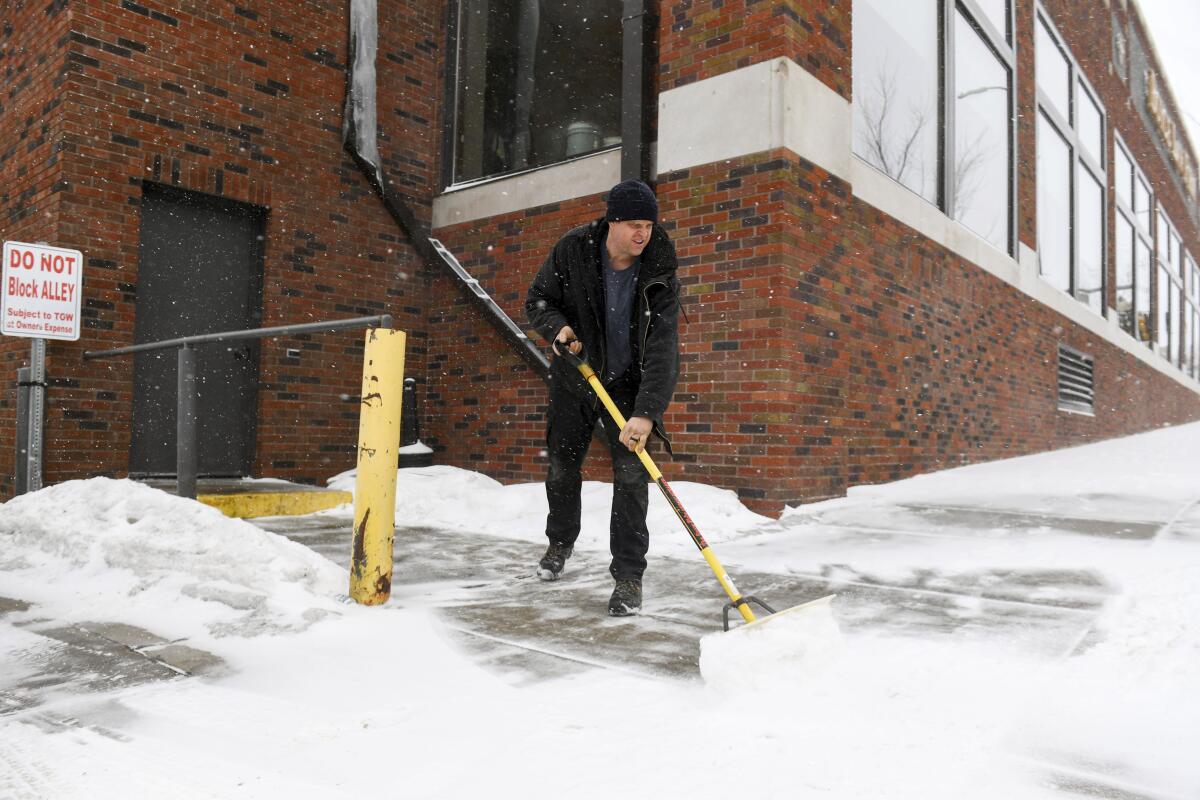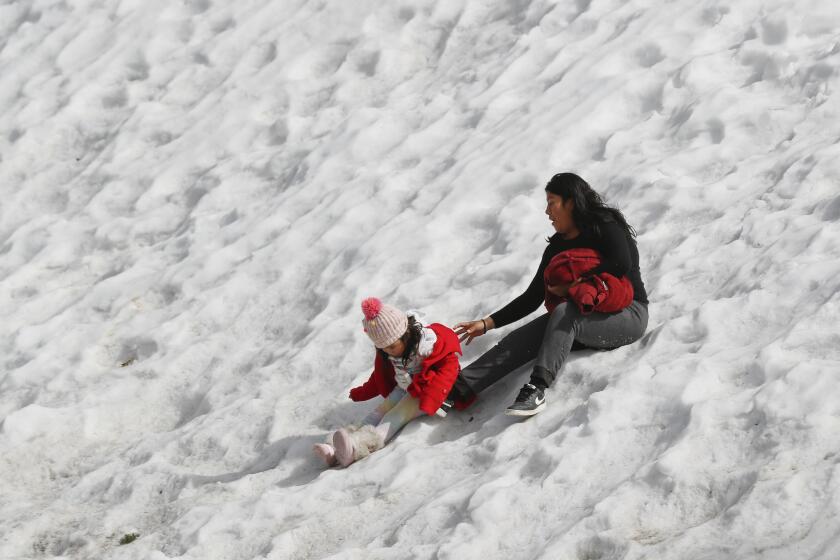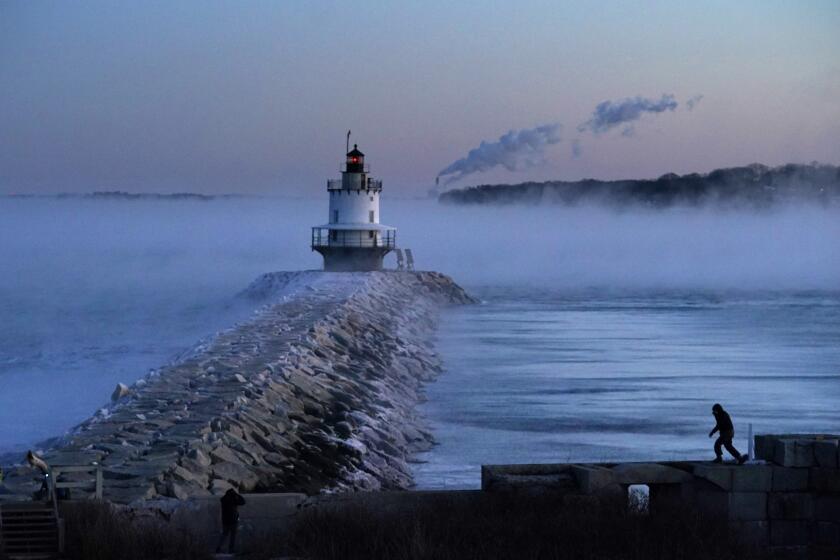Upper Midwest braces for up to 2 feet of snow; blizzard may affect 40 million

- Share via
MINNEAPOLIS — A monster winter storm took aim at the Upper Midwest on Tuesday, threatening to bring blizzard conditions, bitterly cold temperatures and 2 feet of snow in a three-day onslaught that could affect more than 40 million Americans.
The storm began around midday and was to continue through Thursday morning in parts of the Dakotas, Nebraska, Minnesota, Iowa and Wisconsin, with wind gusts as high as 50 mph and wind chills as low as 50 degrees in some places.
The snowfall could be historic, even in a region accustomed to heavy snow. Total accumulation could hit 25 inches, with the heaviest amounts falling across east-central Minnesota and west-central Wisconsin, the National Weather Service said.
The Minneapolis-St. Paul area could see 2 feet of snow or more for the first time in over 30 years.
Some families scrambled to get shopping done before the weather closed in. At a Costco in St. Louis Park, Minn., 52-year-old Molly Schirmer stocked up on heat-and-serve dinners and Mexican Coca-Colas, knowing that she and her two teenagers might get stuck at home.
“The schools are already preparing to go online, so the kids will probably be home doing online school,” Schirmer said of her 13- and 15-year-olds.
The storm is expected to be ‘a snowmaker of the likes we have not seen for many years,’ a forecaster said, with a chance for snow even at sea level.
At another Costco in suburban Eagan, Larry and Sue Lick bought toilet paper, kitchen essentials and coffee ahead of the storm. They also rescheduled medical appointments and a family gathering, just to stay off the roads.
“It’s not so much our driving, but you’ve got to worry about everybody else driving, with so many accidents caused by people that don’t know the winter driving,” Larry Lick said.
The weather service said the blizzard will involve two rounds. For the Twin Cities area, the first blast arrives Wednesday afternoon with up to 7 inches of snow. Round 2, which starts later Wednesday and extends into Thursday, is the real whopper, “with an additional 10 to 20 inches expected.”
Weather service meteorologist Frank Pereira said the system was expected to affect about 43 million Americans.
Forecasters warned of life-threatening conditions.
Temperatures could plunge to minus-20 degrees on Thursday and minus-25 degrees Friday in Grand Forks, N.D. Wind chills may fall to 50 degrees below zero, said Nathan Rick, a meteorologist in Grand Forks.
Wind gusts of 35 mph will be common in western and central Minnesota, with some blowing even stronger. That will result in “significant blowing and drifting snow with whiteout conditions in open areas,” the weather service said.
According to the weather service, the biggest snow event on record in the Twin Cities was 28.4 inches from Oct. 31 through Nov. 3, 1991 — known as the Halloween Blizzard. The second-largest was 21.1 inches of snow from Nov. 29 through Dec. 1, 1985. The Twin Cities got 20 inches of snow on Jan. 22 and Jan. 23, 1982.
Hours before the snow was to start, the storm was already having an effect. Minnesota state lawmakers canceled all committee hearings set Wednesday and Thursday as well as the Thursday floor sessions. Because they don’t normally meet on Friday, legislators won’t reconvene until Monday.
The Arctic air that descended on the Northeast on Saturday brought dangerously cold subzero temperatures and wind chills to the region.
Hardware store owners said residents were generally taking the forecast in stride. At C&S Supply, an employee-owned hardware store in Mankato, manager Corey Kapaun said demand was high for salt and grit, but not for shovels, snow blowers or other equipment. He attributed that to the fact that winter is two-thirds over.
Kapaun said he’s sold 130 to 140 snow blowers and about 1,000 shovels this winter, when Mankato has seen more than 3 feet of snow.
“I think people are either prepared or they’re not,” Kapaun said. “It’s usually the first snowfall of the year that gets a lot of attention. With a storm like this, I expected a little bit more, but we’ve already had a big year of snow.”
For the record:
11:12 p.m. Feb. 21, 2023An earlier version of this story said Sioux Falls is in North Dakota. It is in South Dakota.
In Sioux Falls, S.D., Dallas VandenBos has owned Robson True Value hardware store for 48 years. His customers are used to the snow, but don’t necessarily trust the forecast.
“When we had that storm the first part of January, they told us we were probably going to get 3 or 4 inches of snow, and we got 18 inches,” VandenBos said.
Sales of snow-related items haven’t really picked up, but VandenBos has a backlog of snow blowers to repair. Those bringing them in Tuesday were out of luck — they won’t be ready for a week. “They’re not going to get them in time for this snow,” he said.
Forecasters at Accu-Weather said the same storm system could result in icing along a 1,300-mile band from near Omaha to New Hampshire on Wednesday and Thursday, creating potential travel hazards in or near cities such as Milwaukee, Detroit, Chicago and Boston.
Portions of northern Illinois, southern Michigan and southern New York state could get up to half an inch of ice, which could topple power lines and cause outages, AccuWeather said.
In California, significant snow was possible in the foothills and mountains near Los Angeles, with several inches predicted even for elevations as low as 1,500 feet in the region, the weather service said.
Nearly the state’s entire population “will be able to see snow from some vantage point later this week if they look in the right direction,” UCLA climate scientist Daniel Swain wrote on Twitter.
Potentially damaging 50-mph winds were predicted along the Central Coast, and gusts of 70 mph were possible in the mountains.
As the northern U.S. deals with a winter blast, record warmth is expected later in the week in the mid-Atlantic and Southeast — 30 degrees to 40 degrees above normal in some places. Record highs are expected from Baltimore to New Orleans and in much of Florida, Pereira said.
Washington, D.C., could hit 80 degrees on Thursday, which would top the record of 78 degrees set in 1874.
More to Read
Sign up for Essential California
The most important California stories and recommendations in your inbox every morning.
You may occasionally receive promotional content from the Los Angeles Times.












